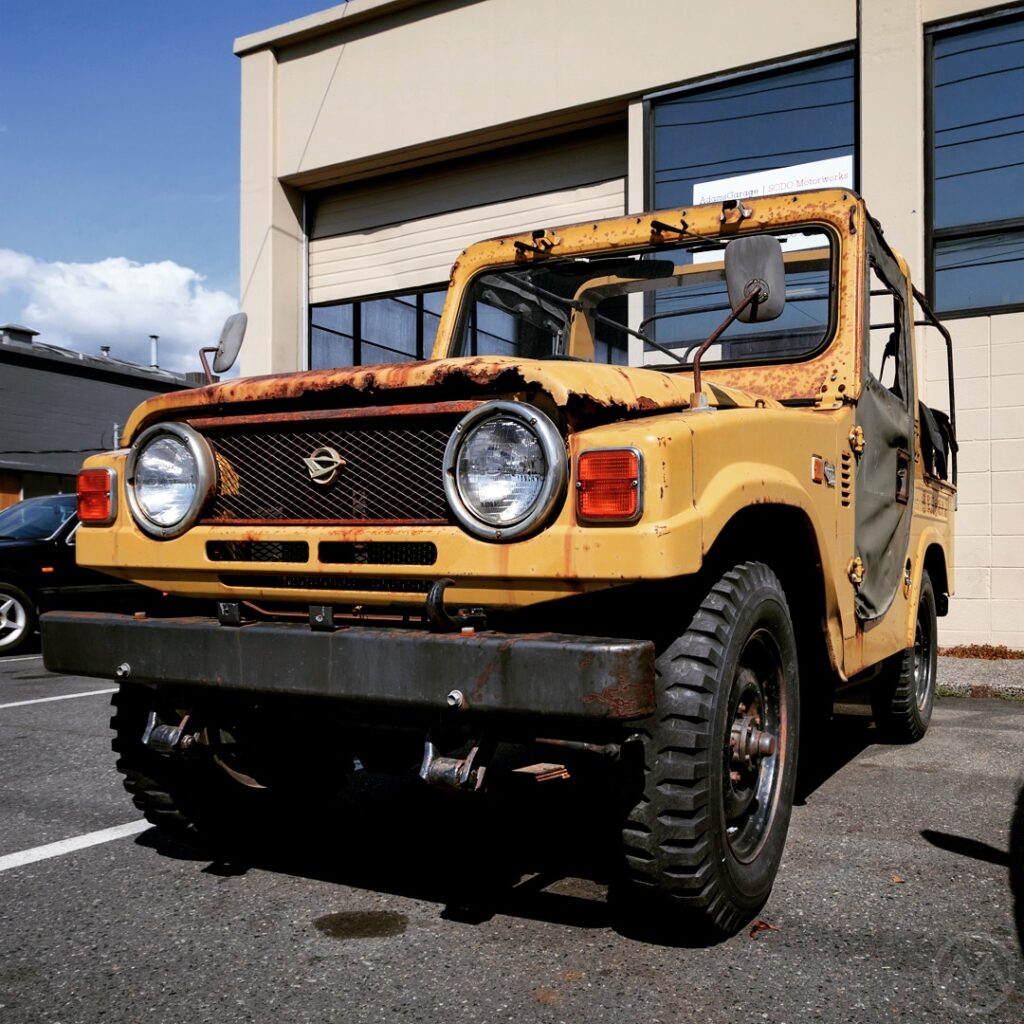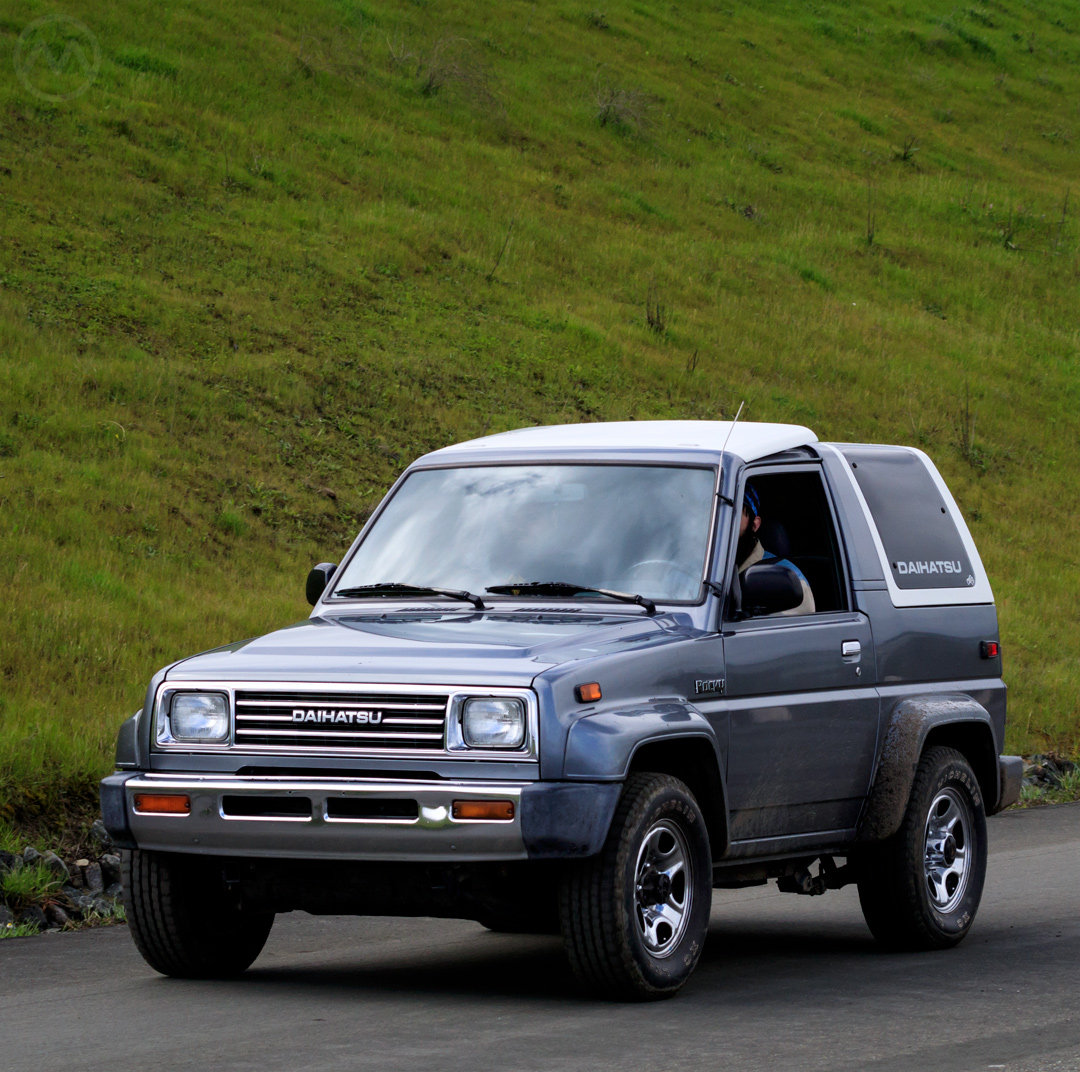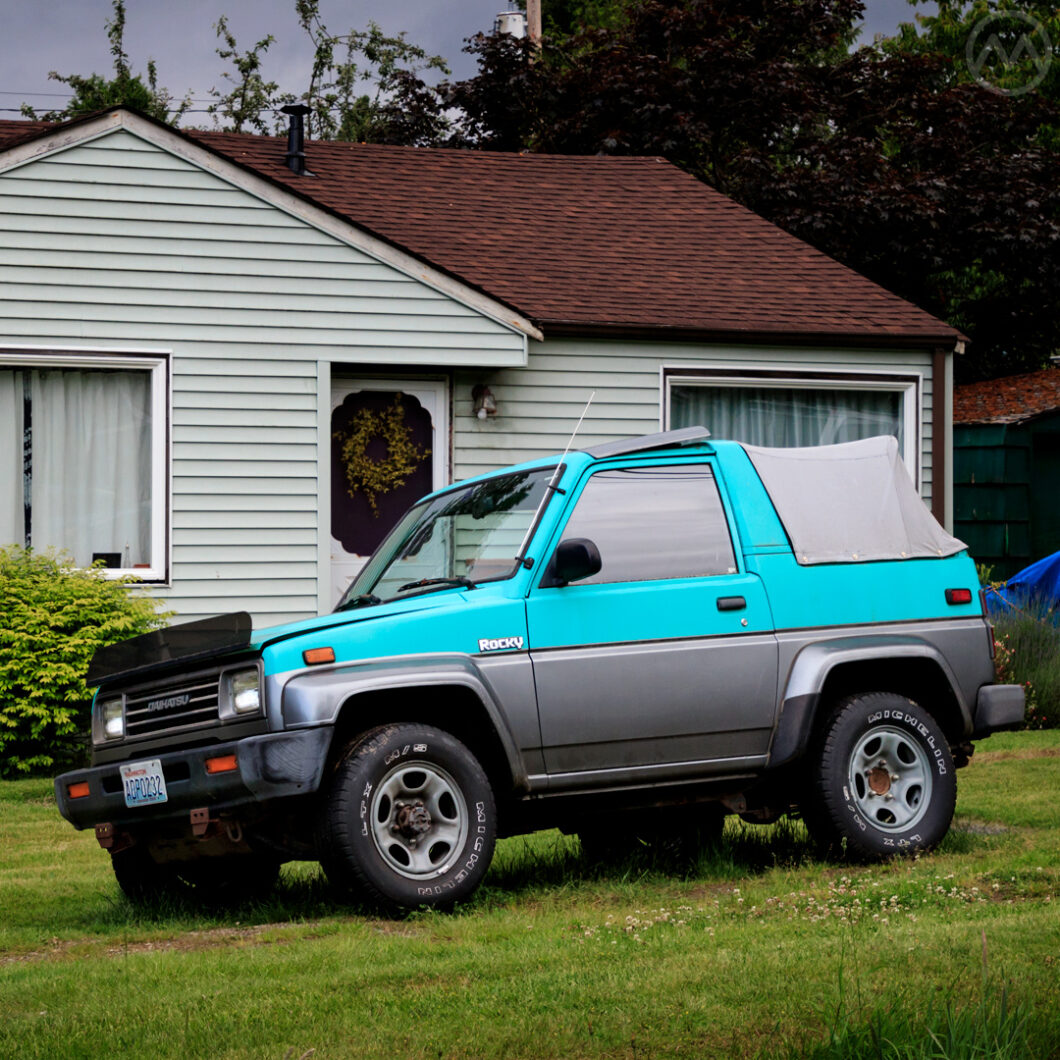At first glance, you might mistake the Daihatsu Rocky for a Suzuki Samurai. But those chunky fender flares and that almost Dodge Ram-like face give away that this is something more unusual even before you see the badges. In other countries, the little F300-series Rocky, also known as the Daihatsu Sportrak, Daihatsu Feroza, and sometimes the Bertone Freeclimber II, is more familiar. But just 7,429 Rockys were sold in the U.S. from 1990 to 1992. If they’d arrived a few years earlier, things might have been different.
As a vehicle, the Rocky was quite good, and it earned lots of critical praise for its good looks, quality of assembly, and genuine off-road capability, even if you had to rev the engine pretty hard on highway runs, and it could get bouncy on broken pavement. Most critics liked it, and a surprising number of them survive today. Unfortunately, for however good Rocky was, its maker and importer couldn’t overcome the bad hand the company’s American efforts had been dealt right from the start, and time ran out just after Valentine’s Day, 1992.
Daihatsu America
Enviously watching the stateside success of other Japanese brands, Daihatsu launched its own U.S. operation in 1986: Daihatsu America Inc. It would be led by C.R. “Dick” Brown, who’d had considerable success before. After serving in the Korean war, Brown had become an executive at Chrysler and later American Motors, only to leave to help set up Mazda’s U.S. operation and dealership network in the late 1960s and early 1970s. After Mazda, he helped get the initial funding for the DeLorean Motor Company and organize the dealer body that would sell John Z.’s famous gullwing sports car.
After DeLorean, Brown hooked up with Daihatsu. By then, all of the other major Japanese automakers had established beachheads in the U.S. After Toyota, Nissan, Subaru, Mazda, Mitsubishi, and Isuzu, Suzuki finally arrived in 1985, and it was probably this arrival that prompted Daihatsu to get serious. Daihatsu has always been a maker of small vehicles and Kei cars, and Suzuki was its closest domestic rival.
Daihatsu has been a part of Toyota since 1998, when the latter bought a majority of the stock, and a partner since it took its first stake (16.8%) in 1967, but in 1986, the two companies were still essentially separate entities. Daihatsu wanted to come to America, but Toyota was not interested in helping or selling Daihatsus at its stores. Suzuki and Isuzu both had support from GM, Mitsubishi from Chrysler, both before and after launching their own U.S. sales networks. Daihatsu was on its own.
The plan was simple. Starting in 1988, the Osaka-based automaker would sell the tiny, three-cylinder Charade, a bargain-basement rival to cars like the Chevy Sprint, Hyundai Excel, Subaru Justy, and even the Yugo GV. As with Mazda in the 1970s and later Kia in the 1990s, sales began in the Western states and would eventually expand eastward. In time, the Charade would be joined by the Rocky, which was due to go into production in 1989. This would give Daihatsu a rival to the Samurai, which became wildly popular in 1986-87.

The Tough and Almighty Touring Vehicle
Daihatsu followed Suzuki and Toyota into the four-wheel drive world. Its first 4×4 SUV was 1974’s F10-Series Taft. Former President William Howard Taft did not inspire the name. Instead, it was an acronym for “Tough and Almighty Four-wheel Touring Vehicle.” It was very much in the same mold as Suzuki’s LJ-series Jimny and the Toyota FJ40 Land Cruiser, with military-grade bare metal everything and corrugated-siding industrial looks. It was not much bigger than a Kei, but it came with a 1.0-liter engine and later larger power units for other countries, so it was bigger and brawnier than Suzuki’s offerings.
The Taft proved quite a good little off-roader, though Daihatsu’s lack of a true international presence meant it never achieved the same fame as Land Cruisers or the Jimny. Still, it sold well enough for Toyota to ask for a badge-engineered version, the Blizzard, in 1981, and it set Daihatsu off on building a larger and better successor in the 1980s, which became 1984’s F30-series Daihatsu Rugger.
The Rugger was closer to a properly global-sized SUV, and came only as a two-door in two different wheelbases. It was a close match for the two-door Mitsubishi Montero, but Daihatsu never added a four-door variation, a significant omission given later market developments.
The Daihatsu Rocky
Being appreciably larger than the Taft, the Rugger left room for a new, smaller design in Daihatsu stores, which became the F300 Rocky. The exterior looked sporty and new, and though we don’t know who penned it in Daihatsu’s internal studios, it was exactly right for its time, a perfect counterargument to the contemporaneous Suzuki Sidekick/Geo Tracker and slightly larger, soon-to-be-launched Isuzu Amigo.
Underneath, many old practices remained, as did some of the parts from the larger F30 Rugger. Unlike the next generation of small SUVs that were even more successful in America, led by the first Toyota RAV4, the Rocky was a very traditional SUV, complete with a ladder frame, just shrunk down into a tiny package. U.S. model Rockys came only one way: with a 90-horsepower fuel-injected 1.6-liter four, a five-speed with low range, and four-wheel drive. It also had a low range and a locking center differential. If you wanted to hit the trail, you really could, and like the Samurai, its small size made it a natural crawler.
Its tall gearing, meant to help do low-speed SUV things on the trail, was a hindrance on the highway, but in general, it was a well-sorted product. In other markets, there were also more versions, including a slightly narrower model for Japan, a later facelifted version with a 1.8-liter engine, and the fancy Bertone Freeclimber II in Europe. This extra-luxe model was modified by the Italian house to look and feel fancier, though it was not so different under the skin. The F30 Rugger, crossed with a BMW engine, had provided the basis of the original 1980s Freeclimber, which had sold better.

The Balloon Goes Up
Both the Charade and the Rocky were fundamentally good vehicles, but right from the start it was clear that Daihatsu would face a very steep climb in the U.S. – much steeper than Suzuki or any of the other more recent Japanese arrivals, though probaly not as big a hill as Toyota had faced in the 1950s.
First, by 1986, the U.S. market was awash with new, cheap, small imported cars. In reaction to the second OPEC crisis and the fuel price spikes of 1981, the Big 3 had gone in search of new high-mpg captive imports like the Suzuki Cultus, which became the Chevrolet Sprint, and the Isuzu Gemini, which became the Geo Spectrum. At the same time, new automakers, like Hyundai and Yugo, had arrived, and at the time, even some Eastern Bloc makers, like Dacia, were considering launching in the U.S. The Romanians even had their cars tested by the EPA for official fuel mileage and certification purposes.
At the same time, fuel prices had fallen and fewer people were interested in tiny cars, which meant the Charade was an unknown new car in an increasingly crowded field. In Europe, Daihatsu launched several years earlier when there was less competition, and its small cars were a better fit for Europe than the U.S. The Charade was a big hit there, and it came in more configurations than it did in the U.S. In hindsight, it might have made more sense to wait for 1989, when Daihatsu launched the Corolla-sized Applause hatchback, which would’ve been more attractive to American buyers.
Second, the Reagan administration’s negotiation of “Voluntary Export Restraints” on Japanese cars meant that each of that country’s automakers got a quota of cars they could sell in the U.S. Daihatsu’s was just 17,000 cars a year. If the venture was successful, that number might eventually have risen, but the Charade’s slow launch meant that Japan’s Ministry of International Trade and Industry (MITI) simply would not increase the quota. By 1992, MITI was actively considering reducing Daihatsu’s allotment. Because it was a light truck, the Daihatsu Rocky wasn’t subject to this quota, but in 1989, the U.S. Customs Service reclassified two-door SUVs and made them subject to the 25% “Chicken Tax” tariff, which annihilated Daihatsu’s profit margin on the Rocky.
Third, Japan’s huge 1980s success had sparked some backlash, a big chunk of it tinged with racism, in the U.S. by 1990, and Japanese cars were the focus of it. Japan was often accused of “unfair” practices, and Japanese automakers in the 1980s were also sometimes said to be subsidized by the state, as some Chinese automakers are today. They weren’t, and if anything, the export restraints were a hindrance to some Japanes companies and an opportunity for other (especially Honda), and Daihatsu’s product choices a real demonstration that they didn’t always get it right.
Another problem? The rising value of the Yen made all exports from Japan pricier. In 1991, Daihatsu’s overseas sales manager, Toshio Yoshioko, said the ultimate answer to all of these issues was to build a factory in America. If Daihatsu could do that, it could probably build commercial trucks and passenger vehicles profitably, but it didn’t have the money for such an effort, and it never got the chance.

Daihatsu Taps Out
With both the Charade and Rocky selling slowly right from the start, the dealer network had trouble maintaining growth. Despite Brown’s best efforts, it peaked at around 250 stores in 1990, compared to 340 for Mitsubishi. Suzuki and Isuzu had their own stores, but their products were also sold at Chevrolet dealers, giving them a much wider group of buyers and better support. The Rocky, it was hoped, would be a big draw for recruiting dealers and finding new customers, but much of its thunder was stolen by the Suzuki Sidekick and Geo Tracker, similar products from those more well-known sources.
Then came the 1991 recession, which destroyed Rover’s Sterling brand and Peugeot Motors of America. That year, Daihatsu’s already low sales fell by 40%, with just 6,202 Charades and 2,761 Rocky SUVs moving off the lot.
By December, management back in Japan was all but done with the experiment and much more focused on the rapidly imploding Japanese economy. On February 15, 1992, the automaker announced that it would cease importing cars and wind down its dealer network. In the end, Daihatsu never went nationwide and never even aired a TV ad for any of its products in America.
Brown, ever dedicated to his craft, was still there. In the announcement, he cited a year-long market study the company had undertaken and noted “Many of these conditions are very negative and are likely to remain so for the forseeable future.” Should they have stuck it out? Maybe, but Daihatsu’s product line would remain very similar for decades to come, and little of it would have appealed. Not everybody was put off, however. Just a month before Daihatsu’s withdrawal, Kia announced that it would start selling cars in the U.S. in 1993.
The vehicle allocation was at the heart of the trouble. If you spend on a national ad campaign but can only sell 17,000 vehicles, you’ll probably sell out and then have to turn away customers. But you can’t attract 17,000 customers without proper marketing. MITI’s PR team said the decision was all Daihatsu’s, they didn’t have much choice. Brown and Yoshioko could not convince MITI to help, but the export restraint system dropped just two years later.

